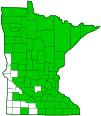wild sarsaparilla
(Aralia nudicaulis)
Conservation • Wetland • Description • Habitat • Ecology • Use • Distribution • Taxonomy
Description |
||
Wild sarsaparilla is a 12″ to 24″ tall, erect, perennial forb. There is no aerial stem. It rises as basal leaves and a flowering stalk (peduncle) from the tip of a long, creeping, 1¼″ to 4¾″ deep, underground stem (rhizome). It often forms colonies. In mid-April or May usually one leaf, sometimes two or three leaves, emerge from the leaf litter. The leaves expand in early spring before the canopy closes. Each leaf is deciduous, 6″ to 15¾″ long, is on a long leaf stalk (petiole), and is divided into three compound segments. The petiole is slender, 6″ to 13¾″ long, light green to dark red, and hairless. It is not spiny. Each primary segment is pinnately divided into usually 5, sometimes 3 or 7, leaflets. The two lateral segments are distinctly asymmetrical, with the inner (toward the terminal segment) leaflets smaller than the outer (toward the petiole) leaflets. The leaflets are narrowly elliptic to broadly egg-shaped, 1¼″ to 6″ long, and up to 2″ wide. The leaflet blade is rounded, narrowed, or somewhat heart-shaped at the base and tapered to a sharp point at the tip with concave sides along the tip. The lateral leaflets are slightly asymmetrical at the base. The upper surface is green and hairless. The lower surface is slightly lighter green and minutely hairy along the main veins. The margins are finely toothed with sharp, forward pointing teeth. The inflorescence appears in May to June. It is a single umbrella-shaped cluster (umbel) of usually 3, sometimes only 2 or as many as 7, umbrella-shaped, secondary clusters (umbellets) of flowers. Each primary umbel is on a long peduncle that rises from the rhizome and has up to 40 or more flowers. The peduncle is 3″ to 10″ long, leafless, and minutely hairy toward the tip. It is usually much shorter than the petiole, causing the inflorescence to be hidden beneath the leaves. Each umbellet is globe-shaped, about ¾″ tall, and 1½″ to 2″ in diameter. The individual flowers are ⅛″ to 3 ⁄16″ wide. The sepals are insignificant. There are 5 petals, 5 stamens with white anthers, and 5 styles. The petals are white or greenish-white, 1 ⁄32″to 1 ⁄16″ long, and strongly bent backward. The stamens have long white filaments that project well beyond the petals. The styles are fused together at the base and strongly appressed together for the rest of their length. The fruit is a globe-shaped, ¼″ to ⅜″ long, purplish-black berry with usually 5 seeds. It matures in about 32 days. It is edible but is not palatable. |
||
Height |
||
12″ to 24″ |
||
Flower Color |
||
White |
||
Similar Species |
||
Bristly sarsaparilla (Aralia hispida) is a much larger plant, up to 60″ tall, that rises on an aerial stem. The stem is leafy and sharply bristly at the base. Northern shagbark hickory (Carya ovata) seedlings look similar to flowerless wild sarsaparilla plants. The outer (closest to the petiole) leaflets of hickory leaves are always smaller than the inner (closest to the terminal segment) leaflets. |
||
Habitat |
||
Moist to dry. Deciduous and mixed woodlands, thickets, river bottoms, prairie edges, bog edges. Shade tolerant. |
||
Ecology |
||
Flowering |
||
May to June |
||
Pests and Diseases |
||
|
||
Use |
||
|
||
Distribution |
||||
|
Sources |
|||
| 2/14/2023 | ||||
Nativity |
||||
Native |
||||
Occurrence |
||||
Common |
||||
Taxonomy |
|||
| Kingdom | Plantae (Plants) | ||
| Division | Tracheophyta (Vascular Plants) | ||
| Subdivision | Spermatophytina (Seed Plants) | ||
| Class | Magnoliopsida (Dicots) | ||
Order |
Apiales (Carrots, Ivies, and Allies) | ||
Family |
Araliaceae (ivy) | ||
| Subfamily | Aralioideae | ||
| Tribe | Aralieae | ||
Genus |
Aralia (spikenards) | ||
Subordinate Taxa |
|||
|
|||
Synonyms |
|||
|
|||
Common Names |
|||
American-sarsaparilla rabbitroot shotbush small-spikenard Virginia-sarsaparilla wild licorice wild sarsaparilla |
|||
Glossary
Compound leaf
A leaf that is divided into leaflets, each leaflet having the general appearance of a leaf, with all leaflets attached to a single leaf stem.
Filament
On plants: The thread-like stalk of a stamen which supports the anther. On Lepidoptera: One of a pair of long, thin, fleshy extensions extending from the thorax, and sometimes also from the abdomen, of a caterpillar.
Peduncle
In angiosperms, the stalk of a single flower or a flower cluster; in club mosses, the stalk of a strobilus or a group of strobili.
Petiole
On plants: The stalk of a leaf blade or a compound leaf that attaches it to the stem. On ants and wasps: The constricted first one or two segments of the rear part of the body.
Pinnate
On a compound leaf, having the leaflets arranged on opposite sides of a common stalk. On a bryophyte, having branches evenly arranged on opposite sides of a stem.
Rhizome
A horizontal, usually underground stem. It serves as a reproductive structure, producing roots below and shoots above at the nodes.
Umbel
A flat-topped or convex, umbrella-shaped cluster of flowers or buds arising from more or less a single point.
Umbellet
A secondary umbel in a compound umbel.
Visitor Photos |
|||||
Share your photo of this plant. |
|||||
| This button not working for you? Simply email us at info@MinnesotaSeasons.com. Attach one or more photos and, if you like, a caption. |
|||||
Luciearl |
|||||
Usually I've just seen the plant without the flower (which is underneath), but this year looking at it closely. OH!, this flower actually goes to this set of leaves which I see everywhere in my surroundings. |
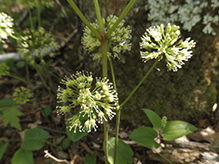 |
||||
Bill Reynolds |
|||||
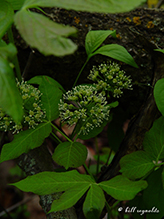 |
|||||
MinnesotaSeasons.com Photos |
|||||
Plant |
|||||
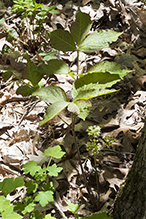 |
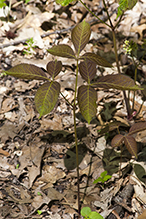 |
||||
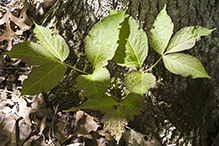 |
|||||
Inflorescence |
|||||
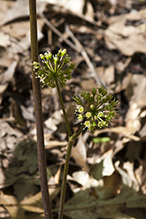 |
|||||
Leaves |
|||||
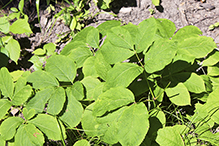 |
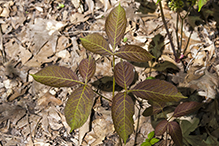 |
||||
Infructescence |
|||||
 |
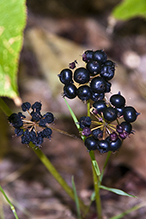 |
||||

Slideshows |
||
| Wild Sarsaparilla (Aralia nudicaulis) Andree Reno Sanborn |
||
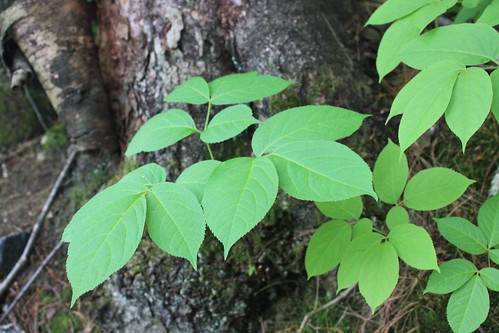
|
||
About
Preferred spring food of Moose, Whitetail Deer. Black Bear consume the fruits. Birds: Food for Ruffed Grouse and thrushes History: Rhizomes have been used to make beverages such as root beer. Uses: Emerges from leaf litter by mid-April or May; Leaves expand before the canopy closes. Flowers May/July. Fruits mature in about 32 days. Leaves begin to drop by mid-September. Dormant in winter. Other common names include Aralia, False Sarsaparilla, Wild Sarsaparilla, Shot Bush, Small Spikenard, Wild Liquorice, Rabbit Root, Salsepareille from www.rook.org/earl/bwca/nature/herbs/aralianud.html |
||

Visitor Videos |
|||
Share your video of this plant. |
|||
| This button not working for you? Simply email us at info@MinnesotaSeasons.com. Attach a video, a YouTube link, or a cloud storage link. |
|||
Other Videos |
|||
| wild sarsaparilla (Aralia nudicaulis ) wvoutdoorman |
|||
About
Published on Apr 23, 2012 wild sarsaparilla (Aralia nudicaulis) plant |
|||
| "The Herb Guy" How to Identify Wild Herb Sarsaparilla KEVINNOAD1 |
|||
About
Uploaded on Aug 9, 2010 How to identify the healing herb wild Sarsaparilla in early spring, the best time to dig up the root for for killing Lyme disease. |
|||
| Wild Sarsaparilla raisingmyhand |
|||
About
Published on Jul 25, 2013 No description available. |
|||

Visitor Sightings |
|||||
Report a sighting of this plant. |
|||||
| This button not working for you? Simply email us at info@MinnesotaSeasons.com. Be sure to include a location. |
|||||
| Luciearl 6/1/2018 |
Location: Lake Shore, MN Usually I've just seen the plant without the flower (which is underneath), but this year looking at it closely. OH!, this flower actually goes to this set of leaves which I see everywhere in my surroundings. |
 |
|||
| Bill Reynolds 6/1/2014 |
Location: Pennington Co. |
 |
|||
MinnesotaSeasons.com Sightings |
|||||
Avon Hills Forest SNA, North Unit Badoura Jack Pine Woodland SNA Carpenter St. Croix Valley Nature Center Charles A. Lindbergh State Park Hardscrabble Woods / MG Tusler Sanctuary Itasca Wilderness Sanctuary SNA Lake Alexander Woods SNA, South Unit Mary Schmidt Crawford Woods SNA Nerstrand Big Woods State Park P.N. and G.M. Nelson Wildlife Sanctuary Robert Ney Memorial Park Reserve |
|||||

|
Created: Last Updated: © MinnesotaSeasons.com. All rights reserved. |
